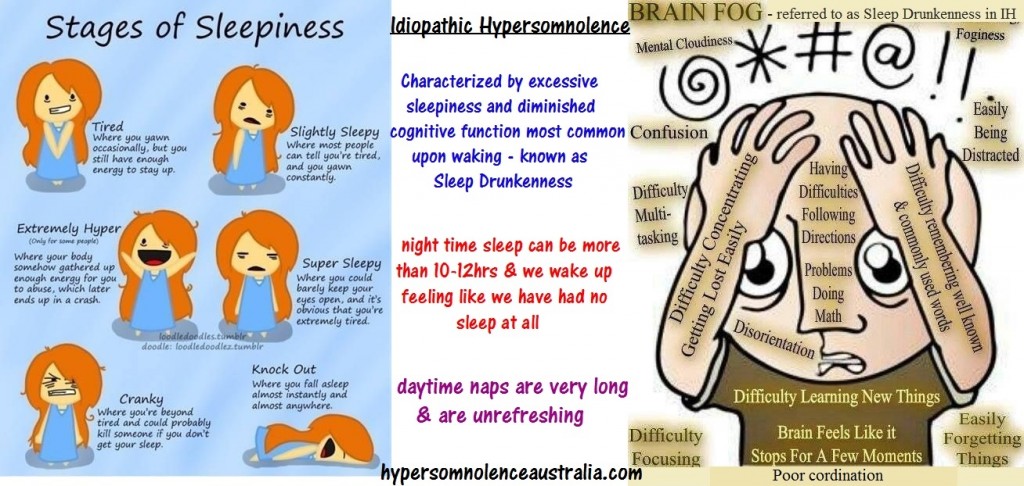 Welcome to our latest guest post of PatientTalk.Org. Michelle Chadwick of Hypersomnolence Australia has graciously written a fascinating blog for us on Hypersomnolence.
Welcome to our latest guest post of PatientTalk.Org. Michelle Chadwick of Hypersomnolence Australia has graciously written a fascinating blog for us on Hypersomnolence.
Idiopathic Hypersomnia – IH (more commonly referred to as Idiopathic Hypersomnolence in Australia) is a rare neurological sleep disorder characterised by excessive sleepiness. Despite sleeping in excess of 10 hours a night people with IH still wake up (either in the morning or at the end of nap periods during the day) unrefreshed and usually also suffer sleep inertia or sleep drunkenness (significant difficulty in coming to complete wakefulness accompanied by confusion, disorientation, poor motor coordination, blurred vision, difficulty expressing & understanding verbal communication, slowness, and repeated returns to sleep) that can often last all day (sometimes referred to as “brain fog”). People with IH can sleep through several alarm clocks and even physical attempts by friends/family to wake them may fail. Daytime naps are generally very long and are also unrefreshing, as opposed to the short refreshing naps associated with narcolepsy.
People with IH experience these symptoms continually for years. Idiopathic hypersomnolence is a lifelong disorder; symptoms typically begin in adolescence or young adulthood and tend to get progressively worse with age. Idiopathic hypersomnolence is often debilitating as the impaired cognitive ability* and continuous feeling of sedation profoundly affects work, education, and quality of life and leaves sufferers at risk of potentially life-threatening domestic, work-related and driving accidents. In addition, some patients exhibit hypersensitivity to sedating medications such as anesthetics, sleeping pills, or alcohol.
Although the sleepiness does tend to worsen and your ability to be able to continue to fight it is tested over time the biggest problem for people with IH as they get older is the loss of their cognitive ability. Where once we may have been professionals, business owners or multitasking working parents we reach a point where all the positive attitude, all the willpower and sheer determination in the world will not make any difference if you simply *cannot* remember how to do the job you have spent most of your adult life doing or you simply *cannot* be trusted to carry out the duties you may have spent years training others to do. The loss of our communication skills can be the hardest blow as it isolates us from the only world we have ever known as we can no longer keep up. Our physical appearance suffers as the struggle to stay awake overtakes simple things like personal grooming, shopping for clothes and even trips to the hairdresser. This of course further isolates us as we become ashamed of whom we have become. Our self esteem plummets and we become at risk of suffering associated depression.
There are no approved treatments in Australia for IH. Doctors prescribe us the only two medications approved for narcolepsy (Dexamphetamine or Modafinil). Unfortunately these medications tend to be less effective for IH than they are for narcolepsy. A prefect analogy regarding these medications is a quote from Dr Jenkins from Emory University. Using stimulants & wake promoting medications “is like flooring the gas pedal in a car with the park brake engaged.” The theory being we need medications that “release the park brake”.
Hypersomnolence Australia (HSA) was set up purely out of necessity. While there are some organisations around the world that advocate for narcolepsy there was nothing that catered to IH. In Australia in particular awareness of IH was almost nonexistent and there was nothing being done to change this. HSA is dedicated to being a strong advocacy, raising awareness & educating others about IH and aims to support all people with IH and to people with Narcolepsy who identify more closely with the type of hypersomnolence experienced in people with IH (ie: no refreshing naps, long sleep times, normal overnight sleep structure etc).
*cognition is a group of mental processes that include attention, memory, producing and understanding language, learning, reasoning, problem solving and decision making.
The term idiopathic Hypersomnolence means:
Idiopathic – ‘of unknown cause’,
Hypersomnolence/Hypersomnia – an extreme or excessive level of sleepiness.
https://www.youtube.com/watch?v=V9gnvWtta4M
The above link is to a video made by Emory University in the States. Emory have made some promising discoveries about IH and have found a novel treatment option in the drug Flumazenil, as discussed in this video. Flumazenil is not approved for use in IH anywhere in the world. Although we can access Flumazenil “off label” in Australia the cost and the issues associated with the current delivery methods mean that it is out of reach for the majority of people with IH & Narcolepsy (there are only two people trying Flumazenil in Australia at present). It should also be noted that the GABA sensitivity identified by Emory is only likely to be the cause for approx 50% of the people diagnosed with IH & Narcolepsy without Cataplexy.
For more information please refer to these links:
http://www.hypersomnolenceaustralia.com/
http://en.wikipedia.org/wiki/Idiopathic_hypersomnia
http://hypersomniafoundation.org/about-hypersomnia

Yes I understand you completely your not alone.
I feel as I have been described better than I could myself and I’m not Australian I’m Mx American…. I feel like this discrimination every day..
To actually see written proven information about this topic..it gives me a since relief…although it scares me knowing everyday I go through mostly by myself…wishing I could make others close to me understand why I do what I want, when I want..this was a great article. Thx
.
You have just described me to a tee and I am Australian. what specifically is the connection with Australia?
Hi Victoria
I’m not sure I understand what you mean with regards to “what specifically is the connection with Australia”
What specifically is the connection between the Not Hypersomnolence Australia and Idiopathic Hypersomnolence?
Sorry, I hit send before I had finished amending the above reply… The last paragraph should be:
Do you mean, what specifically is the connection between the Not For Profit organisation Hypersomnolence Australia and the disease Idiopathic Hypersomnolence??